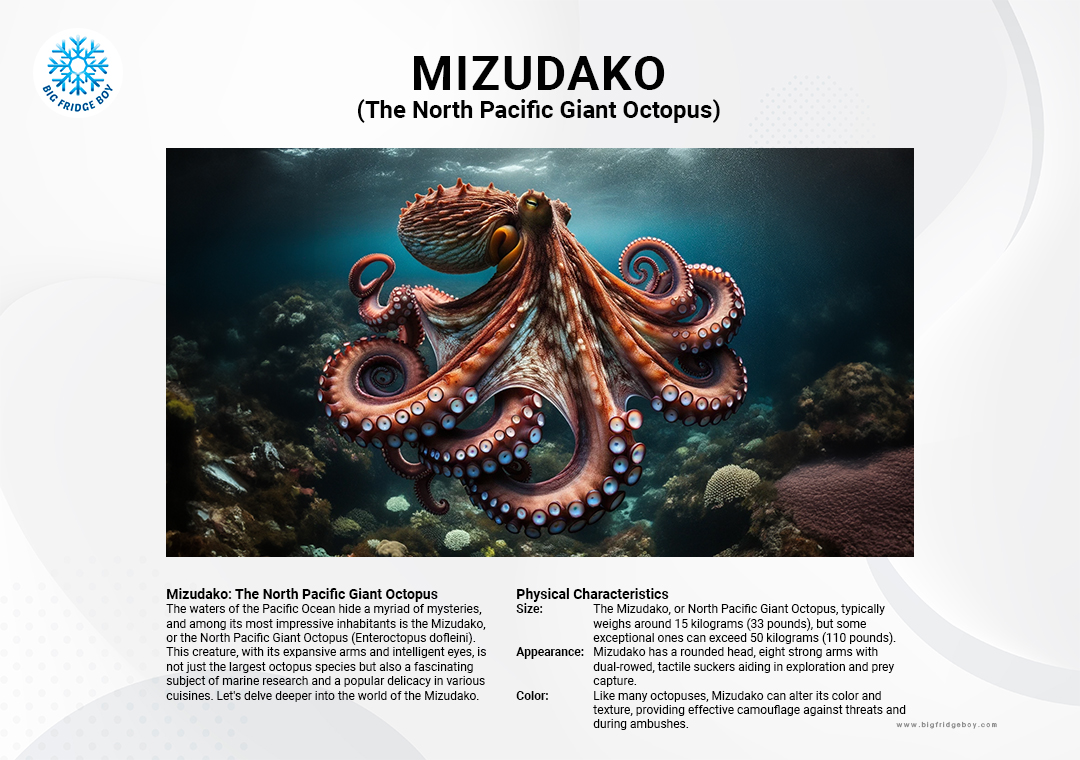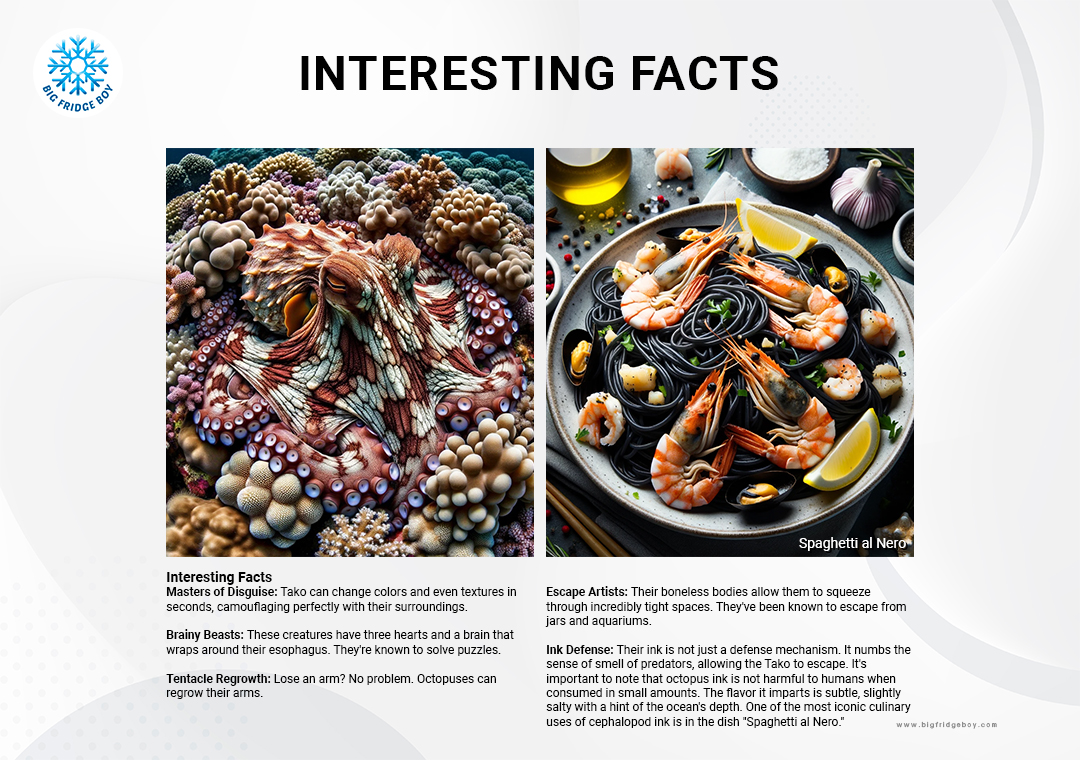"Tako Tales: The Alluring World of the Japanese Octopus"
Last updated: 6 Feb 2024 | 1887 Views |

"Tako" is the Japanese term for "octopus." In Japan, the octopus holds significant cultural and culinary importance. It is prominently featured in various dishes, art forms, and even in traditional folklore and legends. The octopus is appreciated not only for its unique taste and texture when consumed but also for its fascinating biology and behavior. While the term "tako" encompasses octopuses in general, in the context of Japanese culinary traditions, certain species like the "Mizudako" or North Pacific Giant Octopus (Enteroctopus dofleini) are especially popular.

Mizudako: The North Pacific Giant Octopus
The waters of the Pacific Ocean hide a myriad of mysteries, and among its most impressive inhabitants is the Mizudako, or the North Pacific Giant Octopus (Enteroctopus dofleini). This creature, with its expansive arms and intelligent eyes, is not just the largest octopus species but also a fascinating subject of marine research and a popular delicacy in various cuisines. Let's delve deeper into the world of the Mizudako.
Physical Characteristics
- Size: One of the most defining features of the Mizudako is its immense size. A fully grown North Pacific Giant Octopus can weigh up to 15 kilograms (33 pounds), although some exceptional individuals have been recorded at weights surpassing 50 kilograms (110 pounds)!
- Appearance: Like all octopuses, the Mizudako has a bulbous head and eight muscular arms adorned with two rows of suckers. These suckers are tactile and sensitive, aiding the octopus in exploring its surroundings and catching prey.
- Color & Camouflage: Mizudako possesses the ability to change its color and skin texture, a trait common to many octopuses. This capability serves as an adaptive camouflage against predators and when ambushing prey.
Habitat & Distribution
Mizudako is primarily found in the Northern Pacific region, stretching from the coastal waters of Japan, through the Gulf of Alaska, and down to the California coast. They prefer cooler waters and are commonly found in rocky crevices, underwater caves, and among the seabed's boulders.
Diet & Predation
- Diet: The North Pacific Giant Octopus is a carnivorous predator. Its diet mainly consists of shrimps, crabs, lobsters, fish, and even other smaller octopuses. Using its sharp beak (located centrally where the arms converge), it can crack open the shells of mollusks and crustaceans.
- Predators: Despite its size, the Mizudako has natural predators, including sea otters, larger fish, sharks, and even sea birds when they're younger and smaller. Their camouflaging ability often aids in evading these threats.
Lifespan
Life Cycle: The Mizudako, like many cephalopods, has a relatively short lifespan, typically ranging from 3 to 5 years. They are semelparous, meaning they reproduce once and then die shortly after.
Capturing the giant Pacific octopus, known as Mizudako in Japanese, involves specific methods and techniques to ensure successful and sustainable harvests from the cold waters of the Pacific Ocean.
- Trawling
This common method involves dragging a net along the sea floor to catch giant octopuses dwelling in deep waters. The trawl nets are designed to capture these creatures at depths where they typically forage and live.
- Jigging
This more specific method uses jigs with luminous or reflective materials to attract the giant octopus. Attracted by the light or the motion of the artificial bait, the octopus attempts to seize it and is caught by the hooks on the jig.
- Hand Capture
For smaller octopuses or those living near the shore, divers sometimes use direct hand capture methods. This approach requires expertise and knowledge of octopus behavior.
- Technology Utilization
The use of technology to identify giant octopus habitats allows fishermen to target these creatures more efficiently, reducing bycatch of unwanted marine life.
Flavor
To describe Tako's flavor is like painting the colors of the ocean – vast and mesmerizing. Tako boasts a fresh oceanic taste with a hint of sweetness. When cooked, it takes on a slightly chewy, meaty texture, which is both unique and delightful.

Culinary Use
In Japan, the Tako holds both culinary and cultural significance. Its meat is prized for its unique taste and texture, often served as sushi, sashimi, or in various cooked preparations. Beyond the kitchen, its imposing size and intriguing behaviors have led to its presence in regional myths, legends, and art.
- Sashimi & Sushi: Raw, thinly sliced Tako offers a tender and subtly briny experience.
- Takoyaki: These are delightful ball-shaped snacks made of a wheat-flour-based batter filled with minced octopus.
- Tako Wasabi: This dish involves raw octopus mixed with wasabi, serving as a zingy, spicy treat.
- And many more, from grilling to pickling; there's no limit to how you can enjoy Tako!
When it comes to consuming octopus or "Tako" in Japanese, most parts are edible and enjoyed in various dishes. However, certain parts are typically removed before consumption due to their texture, potential for harm, or taste. Here are the parts that are usually not consumed
- Beak: The octopus's beak, located in the center of its arms, is hard and sharp. It's used to break the shells of prey like crabs and mollusks. This part is always removed before preparing octopus dishes because it's inedible and can be hazardous if accidentally ingested.
- Eyes: The eyes of the octopus are generally not eaten. They're typically removed during preparation due to their unappetizing texture and lack of culinary value.
- Viscera/Innards: The internal organs, which include the intestines and ink sac, are usually removed and cleaned out. While the ink can be and often is used in various dishes, the other internal organs are typically discarded.
- Siphon: The siphon or funnel, which the octopus uses for jet propulsion, is sometimes removed, although it can be eaten.
Health Benefits
Squid is an excellent source of nutrition, offering numerous health benefits due to its wide range of nutrients, as follows:
- High Protein: Squid is a source of high-quality protein with all the essential amino acids, helping in the building and repair of body tissues.
- Low Fat: It is low in fat, making it a good option for diets aimed at weight control or reduction.
- Vitamins and Minerals: Includes Vitamin B12, which is crucial for DNA synthesis and nervous system function. It is also a good source of iron, copper, and selenium, which play roles in immune system function, red blood cell production, and cell damage prevention.
- Omega-3: Contains omega-3 fatty acids, beneficial for heart health, helping reduce the risk of heart disease and stroke.
- Cholesterol: While squid contains some level of cholesterol, consuming it in appropriate amounts along with a diet high in unsaturated fats can help maintain cholesterol balance in the body.

Interesting Facts
- Masters of Disguise: Tako can change colors and even textures in seconds, camouflaging perfectly with their surroundings.
- Brainy Beasts: These creatures have three hearts and a brain that wraps around their esophagus. They're known to solve puzzles.
- Tentacle Regrowth: Lose an arm? No problem. Octopuses can regrow their arms.
- Escape Artists: Their boneless bodies allow them to squeeze through incredibly tight spaces. They've been known to escape from jars and aquariums.
- Ink Defense: Their ink is not just a defense mechanism. It numbs the sense of smell of predators, allowing the Tako to escape. It's important to note that octopus ink is not harmful to humans when consumed in small amounts. The flavor it imparts is subtle, slightly salty with a hint of the ocean's depth. One of the most iconic culinary uses of cephalopod ink is in the dish "Spaghetti al Nero."
Tips
Making squid tender and reducing its fishy smell can be achieved with these simple tips:
- Use Lemon or Vinegar
Squeeze some lemon juice or use vinegar mixed with a little water and marinate the squid for about 10-15 minutes. The acid in lemon or vinegar helps to reduce the fishy smell and tenderize the squid. - Use Salt
Rub the squid with salt then rinse it off with cold water. Salt helps to eliminate the fishy smell and cleans the squid effectively. - Boiling Method
Boil the squid in water that has been flavored with basil or kaffir lime leaves for a moment before proceeding with your recipe. These herbs not only help to reduce the fishy smell but also add a pleasant aroma to the squid. - Cold Water Soak
After cleaning the squid, soak it in cold water or ice water for about 20-30 minutes. This method helps to firm up and tenderize the squid. - Use Baking Soda
Marinate the squid with a small amount of baking soda mixed with water for 5-10 minutes, then rinse it off with cold water. Baking soda helps to tenderize the squid and reduce its fishy odor.







